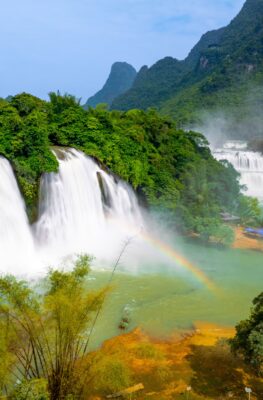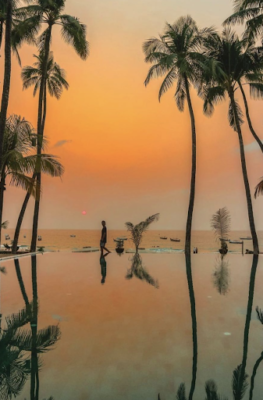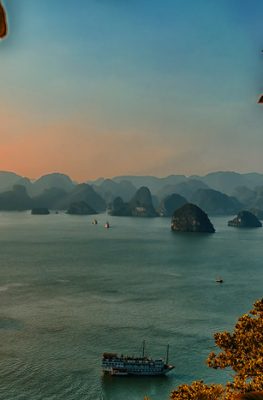Published on March 6, 2018

Cagsawa Church ruins, a relic of a historic Mayon Volcano eruption in the Philippines. Image courtesy of Mike Aquino.
As the recent eruptions of Mayon in the Philippines and Gunung Agung in Indonesia demonstrate, no vacation can be completely insulated from the wrath of nature.
The predictable aftermath – flights cancelled, tourists stranded, airlines making up for the shortfall – can take the fun out of any vacation, whether the consequences are triggered by a typhoon, embroiled in an earthquake, or violated by a volcano.
Smart travelers (like the ones who you’re about to hear from) know how to cushion their trips from the worst “Acts of God”, and come home with nothing more serious than funny stories about their experience. Follow their advice, and you’ll be laughing along with them on your (delayed) flight back!
Plan a more disaster-resistant alternative itinerary. Live Travel Teach‘s Mike Still (Facebook|Twitter|Instagram) grew up in hurricane country in the U.S., and learned first-hand from Hurricanes Sandy and Floyd what a storm can do even to a first-world country.
“[They] took power out for weeks, and blocked roadways,” Mike recalls. “So when I heard that Typhoon Doksuri was headed our way in Cat Ba, Vietnam I knew I didn’t want to find out what it would do.”
If a typhoon menaces your vacation, Mike suggests looking at the potential track area of the storm (the wide path estimated to have a 70% or more chance of being hit) – “If you are anywhere in that range then do your best to get out of it!” Mike advises. “Head inland and stock up on necessities – you’ll need to get at least a hundred miles or so from the coast and should still expect the best case scenario of monsoonal rains and cloudy days.”
Following his own advice, Mike headed up to Sapa instead, “narrowly avoiding the flooding and power outages that ravaged Vietnam’s coast and our friends in Phong Nha where we were just a few days earlier,” he recalls.

Flooded streets in Penang. Image courtesy of Michela Fantinel.
Check weather warnings. Unlike Mike, Rocky Travel‘s Michela Fantinel (Facebook|Twitter|Instagram) was unable to clear the path of Typhoon Doksuri – and experienced the worst of the typhoon first-hand when visiting Penang, Malaysia.
“Waking up in the middle of the night with my room flooded and water level to my calves wasn’t really something I expected,” Michela recalls. “I felt trapped but after the first few minutes of bewilderment, I was thankful to be rescued by the landlords who helped me cross over the flooded road with water high to my knees, and offered a shelter in their home.”
To avoid going through what she did, Michela suggests that “always check weather warnings, and get back to town when heavy rain persists for hours.” You can visit the Hong Kong Observatory’s site for tropical cyclone track information, or read the Philippines’ weather forecast (due to the Philippines’ position between mainland Southeast Asia and the Pacific Ocean, typhoons usually enter the Philippines’ Area of Responsibility first, which their government weather service constantly monitors.)
Keep an emergency fund handy. The eruption of Gunung Agung had dire consequences for Jenny Wieneke, CFO for the Philippines Tokyo Tempura food franchise. “We were set to fly home, we were already at the airport when it was announced that all flights were cancelled because of the eruption and ashfall,” she recalls. “It was chaos at the airport!”
While Jenny and her group were relocated to a new hotel, the additional time spent in Bali meant they could not charge their expenses to the per diem. “I had to use my credit card for the meals, and asked the other managers to charge their departments’ food as well,” she explains.
Jenny says it could have turned out differently if she had had saved some of her pocket money for emergencies like these. “Leave some money for emergency,” she recommends. “In fact, don’t exchange all your dollars just in case you get rerouted to another country (which almost happened to us as well).”

Tourist points to high-water mark of a recent flood in Hoi An, Vietnam. Image courtesy of Mike Aquino.
Can’t avoid it? Take time to socialize. Daniele & Elena of Cycloscope (Youtube|Facebook|Instagram) visited Kuching in Malaysia, just as 300 mm of rain fell in 24 hours.
“The city’s drainage system, designed for a maximum of 180 mm, was unable to cope,” they recall. “With this kind of situation, there was just no way to go out and enjoy the city, but traveling is not just about sightseeing, it’s also about meeting people.”
Daniele and Elena’s hosts put them up in their home in Kuching’s suburbs – putting them in good company as the storm hit. “The day of the flood was actually a great day for us, because we really get to know each other, spending time at home, cooking dinner together, learning recipes from a different place and teaching our own,” they tell us. “To cope with a natural disaster in South East Asia, just make local friends, you may even get a chance to help.”






